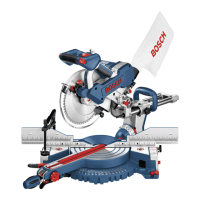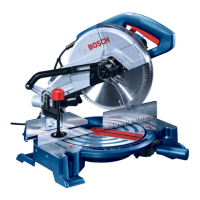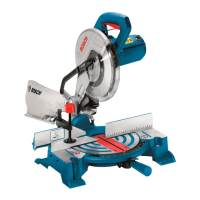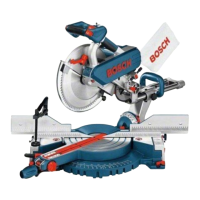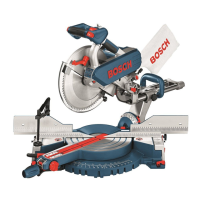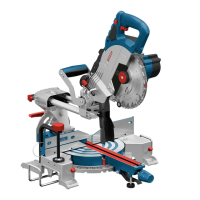English–151 609 929 F69 • (04.10) PS
Checking and Adjusting Basic Adjustment
Before all work on the machine, pull the mains
plug.
To ensure precise cuts, the basic adjustment must be
checked and adjusted as necessary after intensive us#
age.
Bevel Angle 0° (Vertical)
Place the electro#tool in the transport position.
Rotate the saw table 16 to the detent 15 for 0°. The le#
ver 13 must audibly engage in the detent.
To gain access to the adjustment screw that is cov#
ered by the tool holder 42, it must be removed. For this
purpose, unscrew the attachment screw 43 as well as
the nut 44.
Checking: (see Figure
)
Place a combination square set to 90° on the saw ta#
ble 16. The leg of the square must be flush with the
saw blade over its entire length.
Adjusting: (see Figure
)
Loosen the clamping handle 14. Loosen the bolts 64
and 65 with the open#ended spanner 45 (SW 10) pro#
vided. Loosen the adjustment screw 66 (approx. 3
turns) with the socket spanner 33 (SW 4) provided.
Screw the adjustment bolt 63 (SW 10) in or out far
enough until the leg of the protractor is flush with the
saw blade over its entire length.
Retighten the clamping handle 14. Retighten first the
adjustment screw 66 and then the bolt 64 and 65.
In case the angle indicators 22 and 31 are not in a line
with the 0° mark of the scale 30 after the adjustment,
loosen the attachment screws of the angle indicators
with the Phillips screwdriver 33 provided and align the
angle indicators along the 0° mark.
Left Bevel Angle 45° (Vertical)
Place the machine in the working position.
Rotate the saw table 16 to the notch 15 for 0°. Loosen
the clamping handle 14. Swing the tool arm with the
handle 5 to the left to the tool arm stop.
To gain access to the adjustment screw that is cov#
ered by the tool holder 42, it must be removed. For this
purpose, unscrew the attachment screw 43 as well as
the nut 44.
Checking: (see Figure
)
Set the combination square to 45° and place it on the
saw table 16. The leg of the square must be flush with
the saw blade over its entire length.
Adjusting: (see Figure
)
Screw the adjustment bolt 67 (SW 10) in or out far
enough so that the leg of the protractor is flush with the
saw blade over its entire length.
Retighten the clamping handle 14.
In case the angle indicators 22 and 31 are not in a line
with the 45° mark on the scale 30 after the adjustment,
first recheck the 0° adjustments for the bevel angle
and the angle indicator. Then repeat the adjustment
for the 45° bevel angle.
Right Bevel Angle 45° (Vertical)
Place the machine in the working position.
Rotate the saw table 16 to the detent 15 for 0°. Loos#
en the clamping handle 14.
Tilt the tool arm with the handle 5 out of the 0° position
lightly to the left and turn the knob 39 until the bevel
angle range is indicated.
Swing the tool arm with the handle to the right until it
rests on the stop.
To gain access to the adjustment screw that is cov#
ered by the tool holder 42, it must be removed. For this
purpose, unscrew the attachment screw 43 as well as
the nut 44.
Checking: (see Figure
)
Place a combination square set to 135° on the saw ta#
ble 16. The leg of the square must be flush with the
saw blade over its entire length.
Adjusting: (see Figure
Insert the Allen key provided (3 mm) from the outside
through the housing into the hidden adjustment screw
68. Turn the adjustment screw in or out until the leg of
the protractor is flush with the saw blade over its entire
length.
Retighten the clamping handle 14.
In case the angle indicators 22 and 31 are not in a line
with the 45° mark on the scale 30 after the adjustment,
first recheck the 0° adjustments for the bevel angle
and the angle indicator. Then repeat the adjustment
for the 45° bevel angle.
Clamping Action of the Clamping Handle for
the Vertical Bevel Angle
(also see Figure )
Loosen the clamping handle 14.
Adjusting:
Turn the adjustment bolt 69 with the open#ended
spanner 45 (SW 17) counter#clockwise to reduce the
clamping action or clockwise to increase the clamping
action.
Set a vertical bevel angle, tighten the clamping handle
14 and check if the desired clamping action is
achieved.
The clamping force must securely hold the tool arm in
any vertical bevel angle position.
V1
V2
W1
W2
0-45°
W3
W4
W2
